Australia has amazing wildlife some of which is truly unique to the continent and not found elsewhere in the world.
In its animal world, there are 800 species of birds, of which around 350 species are endemic to Australia. Among them are 26 members of the Columbidae family, namely, 16 pigeon species and 10 dove species.
As with all over the world, the various Australian Columbidae species are classified according to the differences between pigeons and doves but they are all obviously closely related.
Australian Pigeon Species:
1. Brush Bronzewing

A subspecies of the common bronzewing, the brush bronzewing is found in South-East and South-West Australia and Tasmania.
A cautious bird, it favours dense shrub and foliage of coastal heathlands, woods and forests.
Their colouring is dark-olive brown top, chestnut body with blue-grey underparts and iridescent bars of green and blue on the wings. The bird’s size is 25-33 cm.
It is non-migratory, a ground-foraging granivore and breeds mostly between September and January.
It lives in small family groups (maximum of eight birds) and has a hoop or whoo call.
2. Chestnut-quilled Rock Pigeon
Similar in habitat and behaviour to its near cousin the white-quilled rock pigeon, the chestnut-quilled rock pigeon is only found in the Northern Territories, most specifically, rock escarpments in West Arnhem Land and Kakadu.
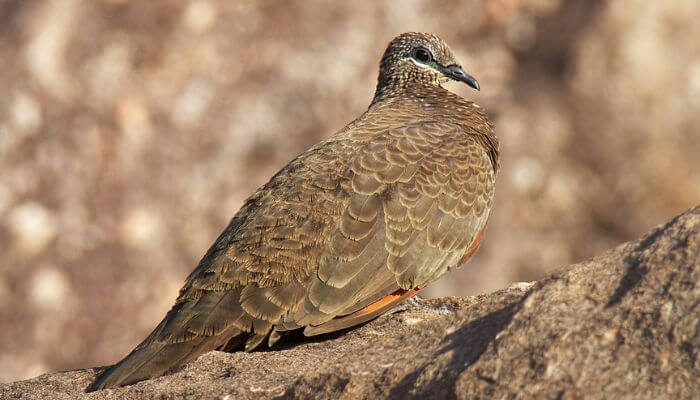
This pigeon’s colour is described as dark sooty brown with pale lines that curve across its face above and below the eye and indistinct white flecking on the head and upper body.
Its most distinctive feature is the conspicuous bright chestnut patch on its wings that are only visible in flight.
The chestnut-quilled rock pigeon measures 28-32 cm, has a long tail and is a skittish bird that takes flight quickly with a loud clapping noise when disturbed.
A sub-species of this is the White-quilled Rock Pigeon.
The white-quilled rock pigeon is similar to the chestnut-quilled rock pigeon in every way except it is also found in the Kimberley region of Western Australia.
The wing patch is white rather than chestnut.
3. Christmas Imperial Pigeon
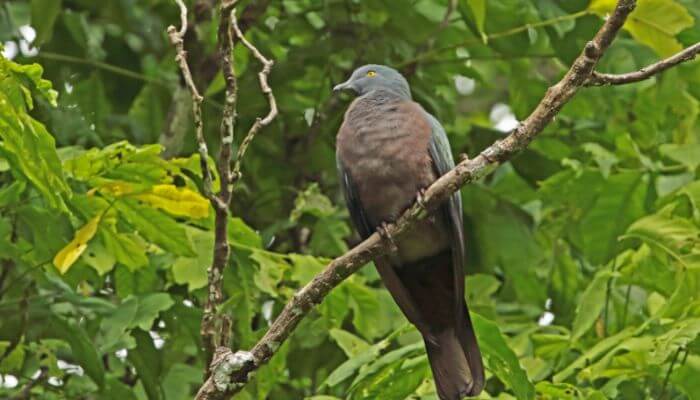
Named for and endemic to Christmas Island, the Christmas imperial pigeon is also known as the dusky imperial pigeon, Wharton’s imperial pigeon, black imperial pigeon and burong pergam.
It is a large bird, 43-47 cm in length, and is overall grey/black in colour. Breast and belly feathers have a burgundy tinge while the nape and back is glossy green. Unusually for a pigeon’s beak, it is black.
This frugivorous pigeon nests and roosts in the dense canopy of the tropical forest inland and its main vocalisations are a soft purring coo and a deeper whoo.
Unlike most Columbidae, the Christmas imperial pigeon only usually lays one egg at a time, not two.
4. Collared Imperial Pigeon
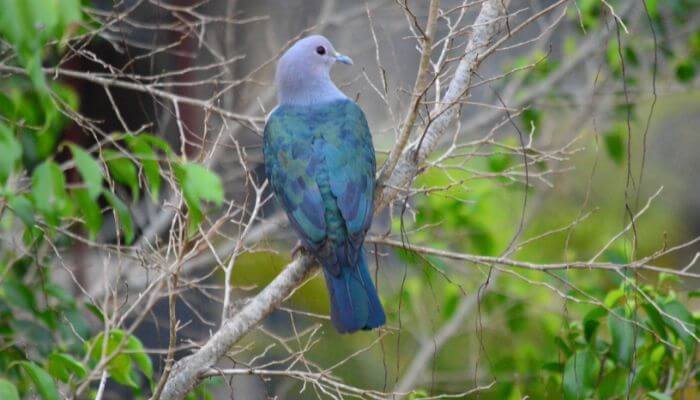
Although mostly native to New Guinea, the collared imperial pigeon is also found on the Aru Islands and Northern Queensland.
This large bird (40 cm) enjoys a habitat of mangroves, riverine vegetation, swamp forest and lowland rainforest where it lives on fruit and insects.
Colourwise, the collared imperial pigeon has a pinkish-grey body, a greyish-brown head and a black neck collar (hence the name). Its wings are dark grey and the dark broad tail has a pale banded tip.
5. Common Bronzewing

A medium-sized, heavily built bird, the common bronzewing is one of Australia’s most populous pigeons.
With a range right across the country, the common bronzewing is happy in most habitats except dense rainforest and barren desert.
Recognisable for the metallic patches of green, blue and red on the wings, this pigeon is mostly brown except for a pinkish breast and pale yellowish forehead with a white line near the eyes.
The common bronzewing grows to 30 – 36 cm and lives on seeds, fruits and vegetation.
Cautious birds, they like to be close to a water source and they have a mournful whooo call which they will sing for a long time.
6. Crested Pigeon
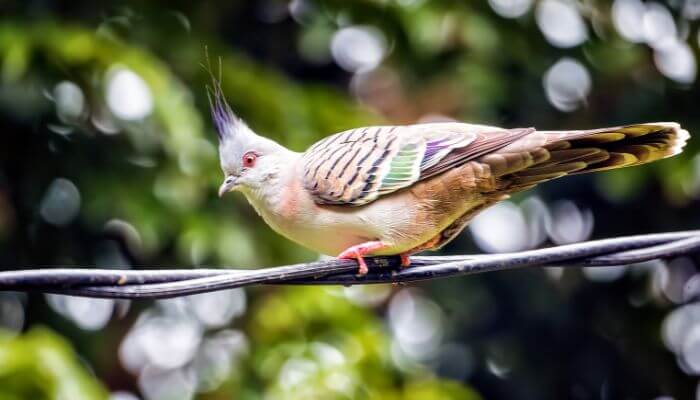
One of only two Australian species of pigeon with a head crest, the crested pigeon is widespread throughout the country apart from the tropical far north.
They inhabit woodland but are regulars on farms and in the city. Ground feeders, their main diet is seeds but they will eat insects.
Growing to 30-34 cm, the pigeon’s body is mainly grey, tinged with green and brown while the wings are bronzed with black stripes but with colourful areas of purple, green blue and brown.
The head crest is a slender black spike which is erect when the bird runs.
A very sociable bird, the crested pigeon has an elaborate mating dance to woo its chosen mate and makes a distinct whistling noise when it takes to flight.
7. Elegant Imperial Pigeon
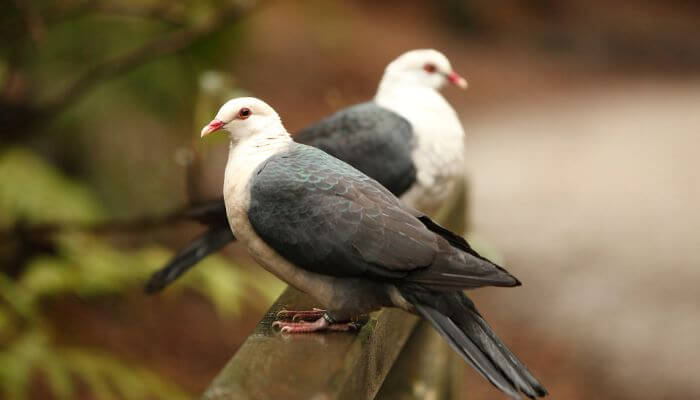
Although mostly native to New Guinea and nearby islands, the elegant imperial pigeon has also established itself around Darwin and the Top End of the Northern Territories.
A frugivore and also known as the blue-tailed imperial pigeon, this species grows to around 45 cm and prefers a habitat of dense rainforest.
The elegant imperial pigeon’s vocalisations are quite different to the expected coo or variation thereof. They make a loud, throaty barking sound (urrauw) variably interspersed with loud, low-pitched growls.
Looks wise, this breed has a pale pinkish-grey head, neck, breast and upper back while the lower back and wings are green/blue/black.
8. Flock Bronzewing
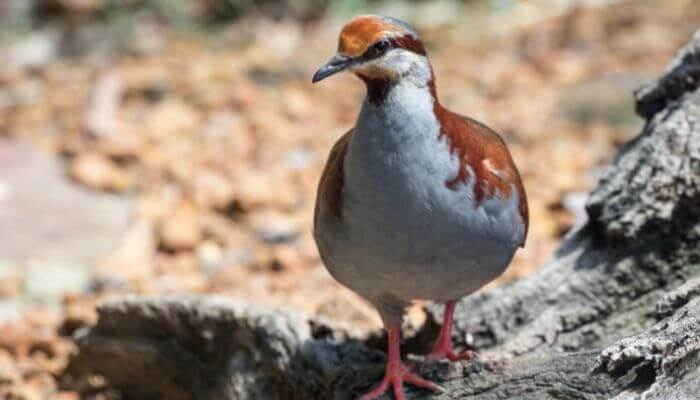
Originally called the harlequin bronzewing and also known as the flock pigeon, the flock bronzewing is found in the drier parts of Australia, particularly arid grass plains.
Even though it is a bronzewing and is known to be one of the most nomadic breeds, it is rare for a specimen to be confused with any of Australia’s other pigeons.
A small breed, it averages 28 – 30 cm in length and only weighs 260 – 320 g.
The flock bronzewing makes its nest on the ground making it easy for pigeon predators.
This pigeon is mostly reddish sandy brown in colour. The head is black and there’s a number of white markings namely, forehead, throat patch and ring from the eye to the ear coverts. The wings are mostly grey with white margins.
9. Metallic Pigeon
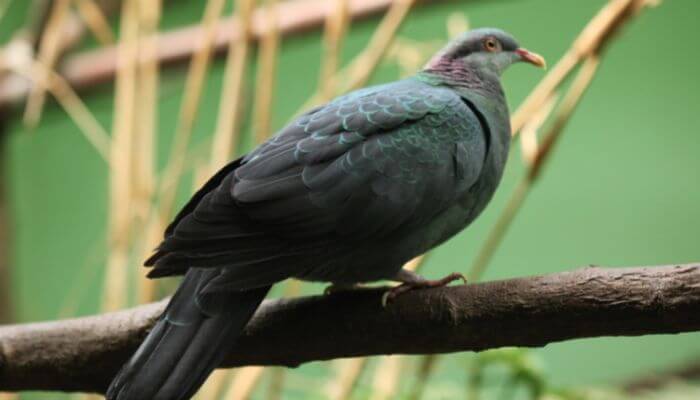
You will often find the metallic pigeon listed as pigeons native to Australia however, this species has been extinct in the country since it was exterminated through hunting by c.1853.
It was a previous inhabitant of Australia’s Lord Howe Island.
Today, the metallic pigeon is found in tropical forests of eastern Indonesia, the Philippines, New Guinea, the Solomon Islands, Fiji, New Caledonia, Samoa and other southwest Pacific islands.
10. Partridge Pigeon
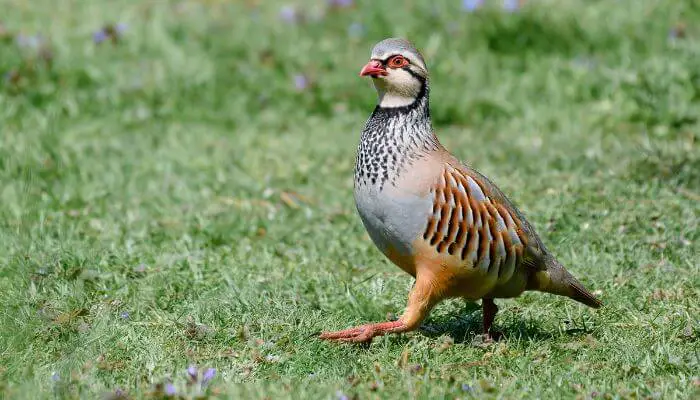
Populous in the Northern Territories Top End, the partridge pigeon is another bronzewing subspecies and is also known as bare-eyes bronzewing, the bare-eyes partridge bronzewing and the bare-eyed partridge pigeon.
A smallish breed, it grows to a length of 28 cm.
It favours habitats of subtropical and tropical dry shrubland and lowland grassland and consumes a diet of grass and acacia seeds.
The plumage of the partridge pigeon is mainly brown but those that dwell in the Northern Territory have red facial skin while those found in Western Australia have yellow facial skin.
They aren’t the best fliers and when they do take flight, there’s a noisy clattering of wings.
11. Pied Imperial Pigeon

The pied imperial pigeon is one of Australia’s migratory pigeons. It is found in the far north during spring and summer where it breeds. In winter, it will migrate to New Guinea.
Its preferred habitats are coastal forest and woodland, scrub and mangroves, where it feeds on fruit, growing to a length of 42 cm.
A fairly large, plumpish bird, the pied imperial pigeon are mostly white with black feathers on the outer wings and tail tip.
12. Spinifex Pigeon
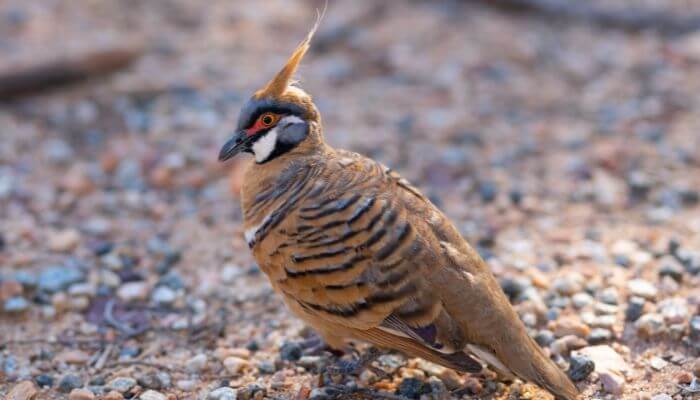
Native to north and central Australia, the striking-looking spinifex pigeon is not found anywhere else in the world.
It is instantly recognisable for its erect head crest which is often described as giving it a mohawk look.
A smallish bird that only grows to around 22cm, its colouring is a brown body with black bars on the back and wings. It does, however, have a magnificently colourful head with bold and distinctive markings.
The spinifex pigeon prefers stony habitats in arid and semi-arid areas and can gather to live in large flocks around water sources.
They are adept at finding seeds, vegetation and insects in extreme conditions.
13. Squatter Pigeon
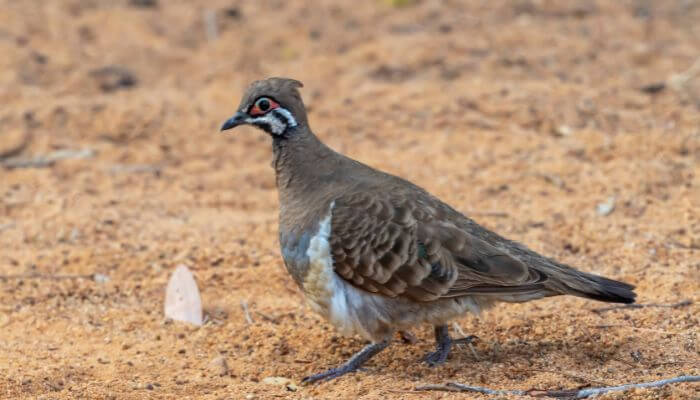
There are two species of squatter pigeon. The most populous is endemic to northeastern Australia. The nominate subspecies, the southern squatter pigeon is, in contrast, listed as vulnerable.
Both prefer arid and semi-arid habitats, including grasslands and dry forests.
Both species of squatter pigeon look similar. Mostly brown-bodied, there is a white stripe along the belly up to the shoulder on each side. They have black and white facial markings and the difference is that the southern squatter pigeon has pink skin around the eyes.
The squatter pigeon is a ground-dwelling medium-sized species that grows to around 30 cm.
14. Topknot Pigeon

A widely distributed bird, the topknot pigeon can be found from Queensland’s Cape York Peninsula to New South Wales’s central south coast.
It has even been known to venture as far as eastern Victoria in search of fruit-laden trees.
Topknots are a protected pigeon species in Australia following a decline in numbers from deforestation.
Predominantly slate-grey in colour, their distinguishing feature is the swept-back head crest.
It typically grows to +40 cm, is a fast flyer and has three distinct calls.
15. Western Crowned Pigeon
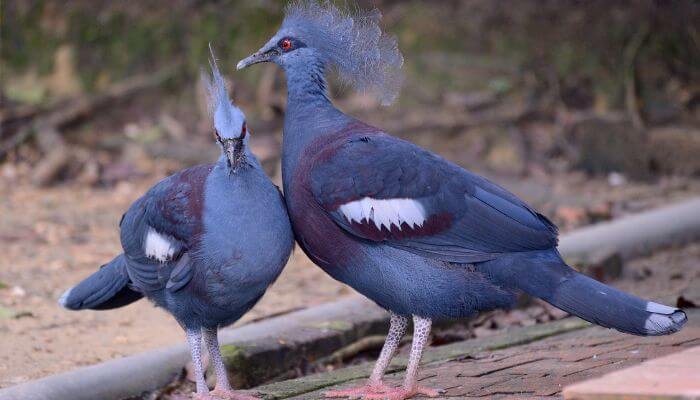
A close relative of the similar-looking Victoria crowned pigeon, Sclater’s crowned pigeon, and Scheepmaker’s crowned pigeon, the western crowned pigeon is one of the largest members of the pigeon family.
It grows to up to 70 cm and weighs up to 2.1 kg.
Distinguished by its blue lacy head crests and dark blue mask, its body is also blue-grey.
A highly prized aviary bird for its looks, it is classed as Vulnerable on the ICUN Red List with a decreasing population due to hunting for its meat and plumes.
The natural habitat of the western crowned pigeon is marshy and wet forests, mangroves and undisturbed hill forest where it lives on fruit and seeds.
Unlike most pigeons, this species lays a single egg and will continue to feed the fledgling for several months, long after other species have ceased feeding their young crop milk.
16. White Headed Pigeon
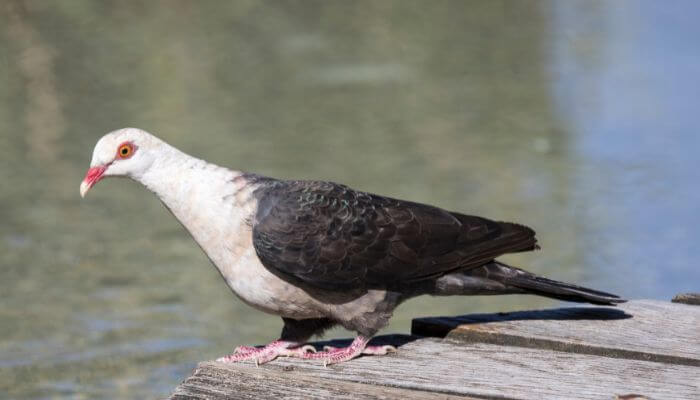
Native to the forest fringes on the east of the Great Dividing Range, the white headed pigeon grows to 40cm on a diet of rainforest seeds and fruit.
This species is named for its white head but white is also the colour of its neck, breast and belly. The wings and tail are slate grey with upper areas of iridescence.
Growing to around 40 cm, the white headed pigeon is closely related to the metallic pigeon which is now extinct in Australia.
Another interesting line of relationships is that while it prefers a habitat of tropical and subtropical rainforest and watercourses, it most favours areas of camphor laurel which is, in fact, an introduced tree species.
Its favourite food is the fruit of the camphor laurel.
17. Wonga Pigeon
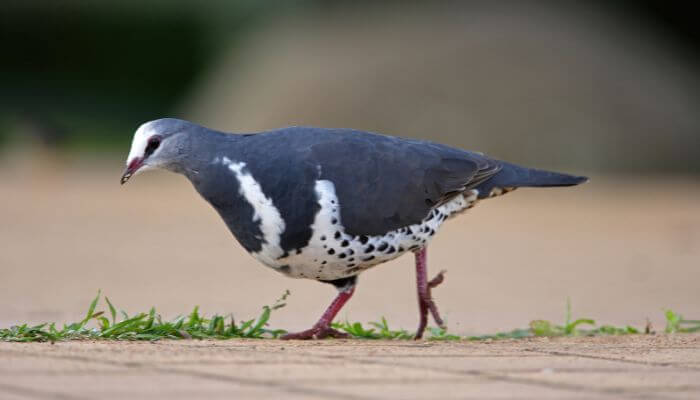
The Wonga pigeon can be found in south-eastern Australia from central Queensland to Gippsland in eastern Victoria.
Its preferred habitat is forest and woodland where it ground forages for seeds, fallen fruit and insects.
Growing to around 40 cm, the wonga pigeon is a large plump species with a short neck, broad wings and long tail.
Colour-wise, its back feathers are pastel grey-blue which fade to a creamy white colour by the time they reach the head. A white V shape can be seen on its chest created by dark grey spots on a white background.
An elusive bird, the wonga pigeon takes flight with a loud clapping noise and its main call is a typically pigeon-like but high-pitched coo.
Australian Dove Species:
1. Bar-shouldered Dove
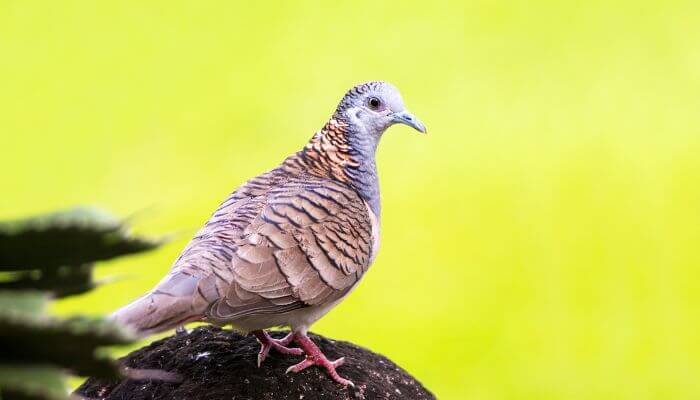
Bar-shouldered doves are found in northern and eastern parts of Australia in woodland, scrubland and also urban areas. They prefer open spaces near a water source.
A medium-sized bird of 26-30 cm length, its body is a greyish brown. The head and upper breast are grey and there is a reddish copper patch with dark bars across the shoulders and neck.
A granivorous species, the bar-shouldered dove lives on grass seeds, sedges, roots and herbaceous plants.
With its melodious call that sounds like cook-a-wook or coolicoo, this is one of the Australian pigeon species protected under the National Parks and Wildlife Act 1974.
2. Black-banded Fruit Dove

This endemic species has a restricted distribution, being found just along Arnhem Land Escarpment’s western edge in the Northern Territory.
Living in patches of monsoonal rainforest, it is a frugivore with a favoured food of figs.
Quite a large species, it grows between 39 to 44 cm and can weigh up to 570 g.
The black-banded fruit dove has a white head, neck and upper breast. The back and upper wing are black, fading to grey on the rump. The tail is black with a broad grey band at the terminal. The broad black band for which it is named demarcates the grey underparts and the white head and neck.
3. Brown Cuckoo Dove

Found the entire length of the east coast of Australia, the range of the brown cuckoo dove extends as far north as The Philippines.
A large bird that grows to 45 cm, it lives in rainforest, woodland and scrubland where it feeds on fruit, berries and seeds from native and alien weed species.
This bird is rusty brown in colour with darker short wings and long tail.
It makes a loud whoop-a-whoop call.
The brown cuckoo dove can be nomadic when there is a need to search for food. They’ll only fly short distances but it is a powerful flight low to the ground.
4. Common Emerald Dove
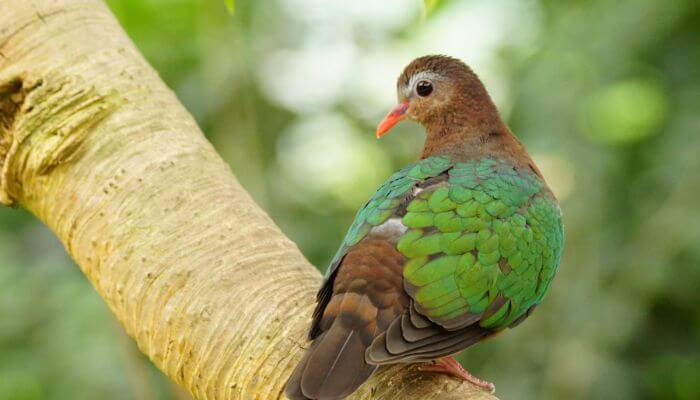
Also called Asian emerald dove, brown-capped emerald green dove and green-winged pigeon, the common emerald dove is found in the forests of northern and eastern Australia.
One of the smaller Australian doves, it grows to 27 cm feeding on seeds and fruit from the ground.
A stocky bird, it gets its name from the bright emerald feathers of its back and wings. Flight and tail feathers are dark grey to black and in flight, broad black and white bars are visible. The underparts and head are dark pink which fades to a greyish tinge on the lower belly. The male also has a white shoulder patch and grey crown.
The common emerald dove spends little time in trees. They are decent flyers adept at weaving through trees but mostly prefer to walk away when startled.
Vocalisation is a song of six to seven coos rising in volume and also a nasal call that sounds like hoo-hoo-hoon.
5. Diamond Dove
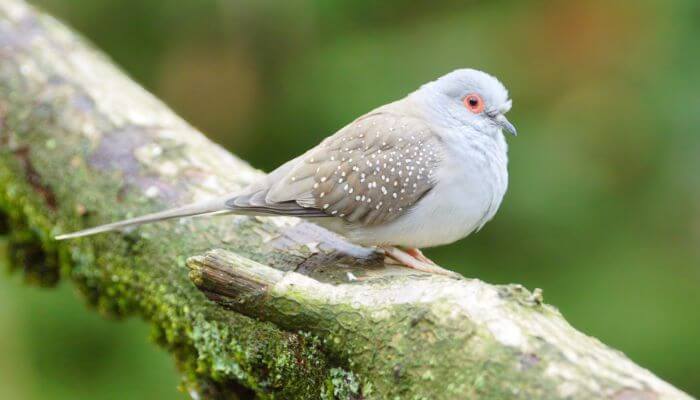
This species is one of the most wide-ranging of Australian Columbidae and is found right across the country except for Tasmania.
Although they prefer to inhabit drier woodland and grassland, they don’t like to be too far from water. The birds are known to migrate to drier areas but incongruously prefer to breed when there is sufficient rain.
One of the smallest pigeons of Australia, they grow to 22 cms.
Ground feeders, the main diet of the diamond dove is grass seeds.
The diamond dove is mainly blue-grey in colour and is named for the small white spots on the darker brown wings and back.
6. Orange-bellied Fruit Dove

Although native to New Guinea and various nearby islands, the orange-bellied fruit dove is also established in the northern Torres Strait and Queensland islands including Boigu Island.
One of the smaller doves, it grows to around 21 cm.
A frugivore, obviously, its preferred food is figs.
The name comes from a large orange area on the lower breast and belly which stands out from the predominantly emerald green plumage. The bird also has a small lilac shoulder patch, pale yellow undertail and a grey band at the tail terminal.
7. Peaceful Dove
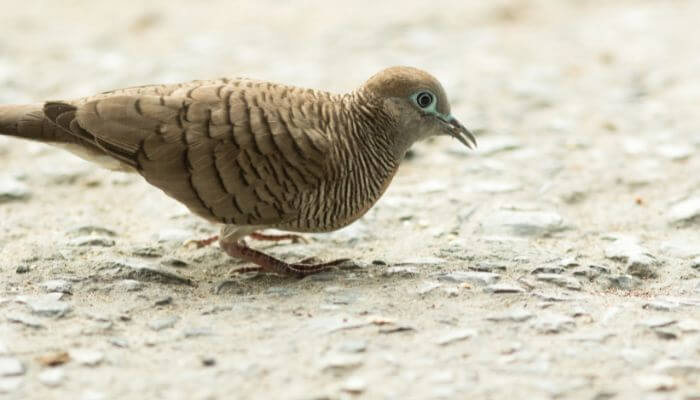
Also known as the doodle-doo and placid dove, the peaceful dove is one of the common pigeons of Australia, found everywhere except for the southwest and Tasmania.
Growing between 20 – 24 cm in length, it inhabits open grassy, dry woodland and rainforest fringes.
A ground feeder, the peaceful dove eats seeds of grasses and sedges and insects.
This small species has a brown-grey body with dark striations that give a barred appearance. The lower body is pinkish and the upper throat is white. Its head and lower throat is a lighter grey and has dark scallops.
The peaceful dove is quite distinctive in the air because it flies in a rapid undulating motion and its wings make a frrr sound.
The population of peaceful doves is reducing as it is being outgrown by the introduced spotted turtle dove.
8. Rose-Crowned Fruit Dove
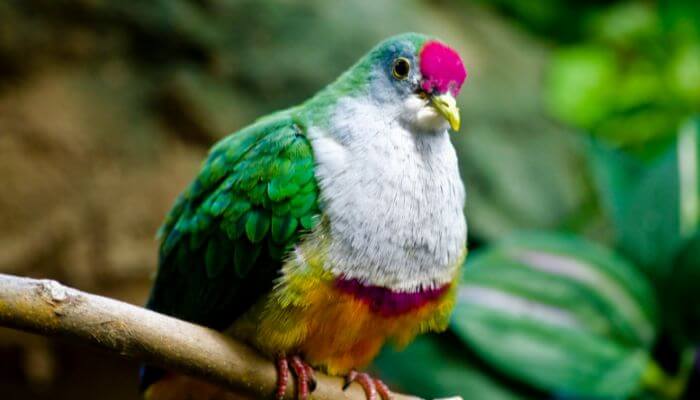
A beautifully colourful bird, the rose crowned fruit dove is a small species, growing to 20 -22 cm.
It is also known as the pink-capped fruit dove or Swainson’s fruit dove.
Its range is the monsoon forests of northern Australia and the lowland tropical and temperate rainforests and wet eucalypt forests of northern and eastern Australia.
Although called a fruit dove, it is sometimes also called the rose crowned pigeon because it eats seeds, berries and small insects besides fruit.
The distinguishing feature is the pink crown with yellow border on its grey head. The bird has a bright green body with grey chest and orange/yellow belly.
9. Superb Fruit Dove

Also known as the purple-crowned fruit dove, the range of this species is the east coast from Cape York in Queensland to southern New South Wales.
Although the ICUN Red List has it as classed as of Least Concern, it is becoming endangered in the south due to habitat loss.
The superb fruit dove prefers the rainforest where it feeds on fruit and seeds high in the canopy.
They are known to consume smaller fruits than most other Australasian fruit doves and will move sites according to food sources.
A medium-sized dove species growing 22-24 cm and despite being highly colourful the superb fruit dove is well camouflaged in the rainforest foliage.
Predominantly green-bodied, this dove has a purple crown, fiery orange nape and grey breast separated from the abdomen by a wide, dark blue band. The tail is white-tipped and the olive-green wings feature dark spots.
The call of the superb fruit dove is a steady coo-coo-coo-coo and its wings whistle when they fly.
10. Wompoo Fruit Dove

One of the larger dove species of Australia, it grows to 48 cm.
The wompoo fruit dove is named for its call which sounds like a loud, explosive wom-pooooo.
It has a similar range to the superb fruit dove but is not threatened with reducing populations along the New South Wales coast.
It too prefers the rainforest where it gathers in large flocks where fruit and seeds are abundant.
They are quite acrobatic in reaching food in the trees and vines but they don’t travel far to eat.
The wompoo fruit dove is predominantly green with a pale grey head. The belly and underwings are bright yellow and it has a purple chest.
Introduced Pigeons and Doves
A number of species are not endemic to Australia, mostly introduced by European settlers.
These are:
1. Spotted Turtle Dove

The spotted turtle dove was introduced from Asia and has established a wide-reaching population range along the east coast, around cities of southern Australia and also in Western Australia.
It grows to 32 cm and is found in agricultural areas, parks and gardens similar to the US mourning dove.
This species is light brown above with a grey-brown underside. It has a distinctive white-spotted black collar.
It feeds on seeds, berries, fruit and small insects.
2. Laughing Turtle Dove

After being released from Perth Zoo in 1898, the laughing turtle dove successfully established itself in Western Australia.
It is widely distributed across the world in Europe, north and west Africa and Asia.
A slim bird with a long tail, it grows to about 25 cm.
A mainly pinkish-brown dove, it has a lilac-tinged neck and head. There is a patch of red and grey check on the sides of the neck.
3. Feral Pigeon

Whether you call it a wild pigeon, a common pigeon or a feral pigeon, there are 120 million of them worldwide.
It is unlikely that as they have managed to colonise every continent other than Antarctica that Australia would be free from the feral pigeon.
It was introduced to the country by Europeans but there are no historical records of when.
There is no difference between Australian feral pigeons and feral pigeons elsewhere.
4. White Dove

This too is a species introduced by Europeans when they settled in Australia.
A white dove is in fact a white pigeon.
In Australia, the same symbolism of doves is applied as elsewhere in the world.
Pigeons and Doves Listed as Extinct in Australia
According to the Environment Protection and Biodiversity Conservation Act 1999, 22 birds have become extinct in Australia and the list includes three from the Columbidae family.
1. Norfolk Ground Dove
Named for Norfolk Island where it was originally found, the Norfolk ground dove became extinct in the late 18th century due to predators introduced by European settlers.
No physical specimens remain and the only record is a drawing by John Hunter for the book Collection of 100 original watercolours of Birds, Flowers, Fishes and Natives which was collated in 1788–1790 in New South Wales.
2. Lord Howe White-throated Pigeon
This was a subspecies of the metallic pigeon which is also now extinct in Australia but exists elsewhere.
An original inhabitant of Lord Howe Island, it went extinct in the 1850s mainly after being prey for human consumption.
The Lord Howe pigeon was mostly brown, with a purple head and breast, and a white patch on its throat.
3. Norfolk Island New Zealand Pigeon
The Norfolk Pigeon, or to give it its full name, the Norfolk Island New Zealand pigeon was a subspecies of the kereru.
This bird endemic to New Zealand settled on Norfolk Island until it became extinct at the turn of the 20th century.
Its demise was caused by the introduction of European cats and weasels and human hunting.
